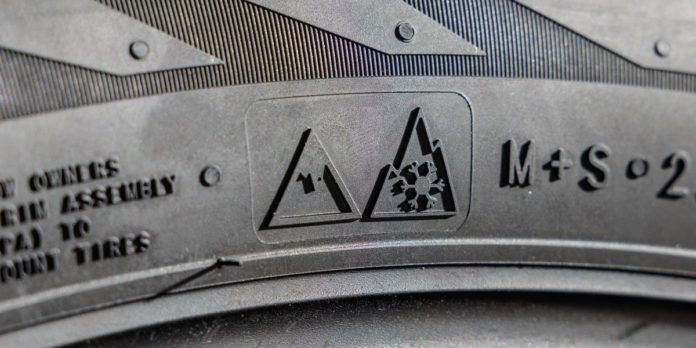The three-peak mountain snowflake (3PMSF) has been a badge of achievement since its development in 1999. Tires wearing the symbol signified the completion of acceleration testing in medium-packed snow, where the 3PMSF tire is verified to accelerate with at least 110 percent of the traction of an all-season reference tire. Now there’s a braking test to acknowledge a winter tire’s ice performance with another sidewall designation.
The new ice-grip symbol on winter tires separates what delivers excellent traction for acceleration in snow from what’s also good at slowing down on ice. We asked Tire Rack testing manager TJ Campbell for the skinny on the new rating, and he told us: “The tire industry recognized the need for an identifier that would help distinguish dedicated winter tires from the proliferation of three-peak mountain snowflake branded all-season tires.”
The new rating, approved by the technical committee at the International Organization for Standardization (ISO), means winter tires now have an internationally agreed-upon test for traction on icy surfaces concerning braking. For the nerds, the standardization can be found in your ISO bible under Psalm 19447:2021. This standard of testing, approved in 2021, allows winter tires with an ice grip index of 1.18 or higher—that is, 18 percent more grip than the reference tire—to earn a rubber sidewall illustration of an icy mountain peak.
For now, we’ve only seen this new emblem appear on the sidewall of the newest-generation studded Nokian Hakkapeliitta 10 and non-studded Hakkapeliitta R5s. Nokian’s Wes Boling told us they used various front-wheel-drive cars during this specific test, including a Volkswagen Golf. He also pointed out that the rubber and resins in these specific ice-rated tires play better in extremely cold temperatures, lower than your typical winter tire would. We expect this pictograph will start appearing on more tires as companies launch new and updated products in the future.
How They Test It
The test method is about as straightforward as finding your way around the skating rink in a Zamboni. The test must take place on a flat surface of polished ice that has been watered at least an hour before the first of three brake tests is attempted. The ice surface is then preconditioned with a test vehicle wearing a set of tires not to be included in the test. The preconditioning is measured with standardized all-season reference tires (P225/60R-16 97S as defined in ASTM F2493; eat up, nerds!) to ensure the surface is properly prepared, effectively setting the target against which it will compare the winter tires.
During the test, it can’t be snowing or raining, avoiding direct sunlight is optimal for obvious reasons, and windy weather should be considered adverse conditions. Hey, before we get too far into this, if you are trying this at home, avoid facing directly at any shanty towns. You risk scaring off all the perch and walleye. The air temperature, which is measured about three feet off the surface, has to be between 5 and 39 degrees Fahrenheit, while the temperature of the conditioned ice surface should measure between 5 and 23 degrees Fahrenheit.
While the hockey coach’s 1977 Mercury Marquis Brougham might be the easiest test car to source, the test vehicle should be a passenger car with ABS that is able to accept multiple tire sizes. No ballast, or additional weight, specifically positioned to increase the load of the tires, is allowed, but the test car can wear wheel adapters or spacers of up to 2.3 inches thick when needed. The break-in procedure for each test tire consists of at least 62 miles of travel on dry pavement and it must be completely free of any snow and dirt before testing.
The test is completed at 12 to 15 mph with a minimum of nine total tests, with the highest and lowest values removed to establish a rating. Once the results are in, we imagine engineers Teemu and Jari share a mug of hot cocoa before hitting the sauna.
Safety First
All that to say, we consider winter tires an absolute must in severe snowy conditions, and tires with the new ice grip symbol have been proven to stop a vehicle sooner. We should point out that the reference tires used in the test aren’t winter tires but all-season rubber, the same tire used by tire manufacturers looking to stamp the 3PMSF on their all-weather or winter rubber.
As with any driving situation involving severe snow and ice conditions, the safest way to drive is with care and patience. That means beginning deceleration to a stoplight earlier. Also, make sure your vehicle is clear of snow before leaving. Yes, that especially means the roof. And here’s an idea: If your car is white, gray, or silver and it’s snowing out, drive with your headlights on to make your vehicle easier to spot.
Remember, even though you’ve thought ahead and carefully equipped your vehicle with the best tire technology for the worst conditions, drive with the understanding that many people on the road didn’t.
Associate Editor
Yes, he’s still working on the 1986 Nissan 300ZX Turbo project car he started in high school, and no, it’s not for sale yet. Austin Irwin was born and raised in Michigan, and, despite getting shelled by hockey pucks during a not-so-successful goaltending career through high school and college, still has all of his teeth. He loves cars from the 1980s and Bleu, his Great Pyrenees, and is an active member of the Buffalo Wild Wings community. When Austin isn’t working on his own cars, he’s likely on the side of the highway helping someone else fix theirs.

